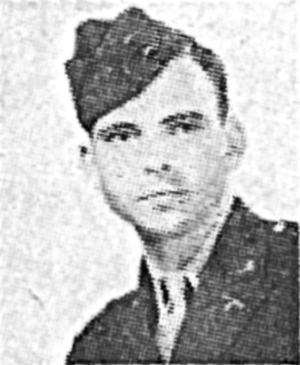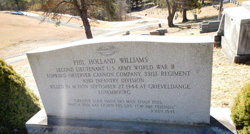
A Pictorial and Documentary Sampler

Remember...
Phil Holland Williams
1921-1944
"In War: Resolution. In Defeat: Defiance. In Victory: Magnanimity. In Peace: Good Will."
British Prime Minister Winston Churchill
Phil Holland Williams was born on April 10, 1921, to Phil and Ruth Troutman Williams in Randolph County, West Virginia. In the 1930 Federal Census, the census taker recorded that they were living in Leadsville, West Virginia, an unincorporated area adjacent to Elkins. Mr. Williams was an operator in the timber industry. With Mr. and Mrs. Williams lived Judith Troutman, the mother of Mrs. Williams, and the children, Phil Holland and Martha Barrett. In 1940, the family lived in the same home, with the same family members, as they did in 1930. Mr. Williams was described as a coal operator by the 1940 census taker.
The newspaper death notices that list Phil Holland Williams's accomplishments by the end of his life start in his high school years, when he attended Elkins High School. The portrait painted is one of an outgoing young man who enjoyed an active life, physically and mentally. He graduated from Elkins High School in 1938 and attended Davis and Elkins College from 1938 to 1939. In the summer of 1939, he attended Culver Military Academy in Indiana, which offered opportunities for summer camps as well as a full course of instruction and leadership training. From there, he entered West Virginia University in the fall of 1939 and earned a bachelor of arts degree in economics in 1942. He entered WVU Law School in 1942.
Throughout the years he spent in education, he also joined societies and clubs and kept up with hobbies. In WVU yearbooks of various years, Phil Williams is pictured or listed as part of Phi Kappa Psi-Alpha Chapter, the WVU Varsity Rifle Team and ROTC, and the university Men's Glee Club.
He also enjoyed hobbies such as horsemanship and photography.
Phil Williams registered for military service on January 8, 1943, in Morgantown, West Virginia. He was 21, still a student living in Men's Hall at WVU. From the physical descriptor on the back of his draft registration card, Williams was six feet tall and weighed 175 pounds, with brown hair and brown eyes and a ruddy complexion. Only a few weeks later, Williams was inducted at Fort Hayes, Ohio, on February 10, 1943. He completed the military course later that spring. He served at Camp Perry and then entered the Army Officers' School at Fort Benning, Georgia. He was commissioned on December 13, 1943, and assigned to Camp Shelby, Mississippi. From there, he moved to Fort Meade, Maryland, and then sailed for England, May 11, 1944. With the 331st Infantry Regiment, he went ashore at Omaha Beach, Normandy, in June. He participated in the Normandy, Brittany, and Luxembourg campaigns. In addition, he fought at Saint-Lo and Saint-Malo.
A death notice for Lt. Phil H. Williams in the Hampshire Review on October 18, 1944, notes: "Anxious for duty at the front he was in France three weeks after landing in England and on July 6 had the experience of being captured by German troops and escaping back to his own forces."
Because Phil Williams was awarded the Silver Star for gallantry, there is a detailed account of the actions that ended with the loss of his life and justified that medal. The Randolph Enterprise on May 31, 1945, reported that the ceremony where his mother received the medal posthumously was "impressive." ("Mrs. Williams Receives Son's Silver Star at Ceremony.") Public relations officer Lt. Joseph G. O'Reilly read from the citation as Col. Clyde M. Beck made the presentation, which reads, in part:
Second Lt. Williams directed close and continuous artillery support for the attack of that company. With utter disregard for his safety he held the observation post under heavy enemy fire until forced to withdraw. Realizing the excellent strategic value of the observation post he led his men forward and drove the enemy from the position and continued to hold the post with his enlisted radio operator until he was killed by enemy fire. Lt. Williams' heroic performance of duty and personal aggressiveness reflect the highest credit upon himself and the finest traditions of military service of the United States.
The after-action report for September for his unit, 331st Regiment, 83rd Infantry Division, also describes the events that led to his death. In summary, though most of the regiment's companies reported no enemy activity in the areas where they patrolled, Company I, in which Phil Williams was an officer and forward observer for the cannon company, received artillery and mortar fire most of the day of September 27, 1944. Company I occupied the town of Grieveldange by noon that day and the high ground to the northeast and southwest, with plans to next move east and continue to take high ground between the town and the river. The operations resulted in 25 casualties, three of whom were killed. One of the three was Phil Williams. As is noted in the after-action report, Lt. Williams was killed by a mortar fragment.
An unsigned editorial in the Randolph Review of October 22, 1945, describes Phil Williams as "a charming, lovable lad, so devoted to his parents, his lovely younger sister and a wonderful grandmother, whom he idolized." The writer went on to say that "he had all of the attributes and the instincts of a Galahad in the purity of his heart, in his unselfishness, in his kindness and thoughtfulness of others, more especially his older friends, with always a cherry [sic] greeting and pleasant thought and word for everyone." The article continues with effusive praise and words of mourning and the sadness for the loss of such a one from the community, though it's hoped his "influence will never die."
On October 22, 1948, the Randolph Review announced that Phil Williams's remains had "come home." The article repeats the facts regarding his service and death and lists awards given him, including the Combat Infantry Badge, the Purple Heart, three battle stars, and the Silver Star.
| Lt. Phil Holland Williams was interred in Maplewood Cemetery in Randolph County. |  Gravestone for Lt. Phil Holland Williams, Maplewood Cemetery. Courtesy Cynthia Mullens |
Article prepared by Cynthia Mullens
December 2019

West Virginia Archives and History welcomes any additional information that can be provided about these veterans, including photographs, family names, letters and other relevant personal history.